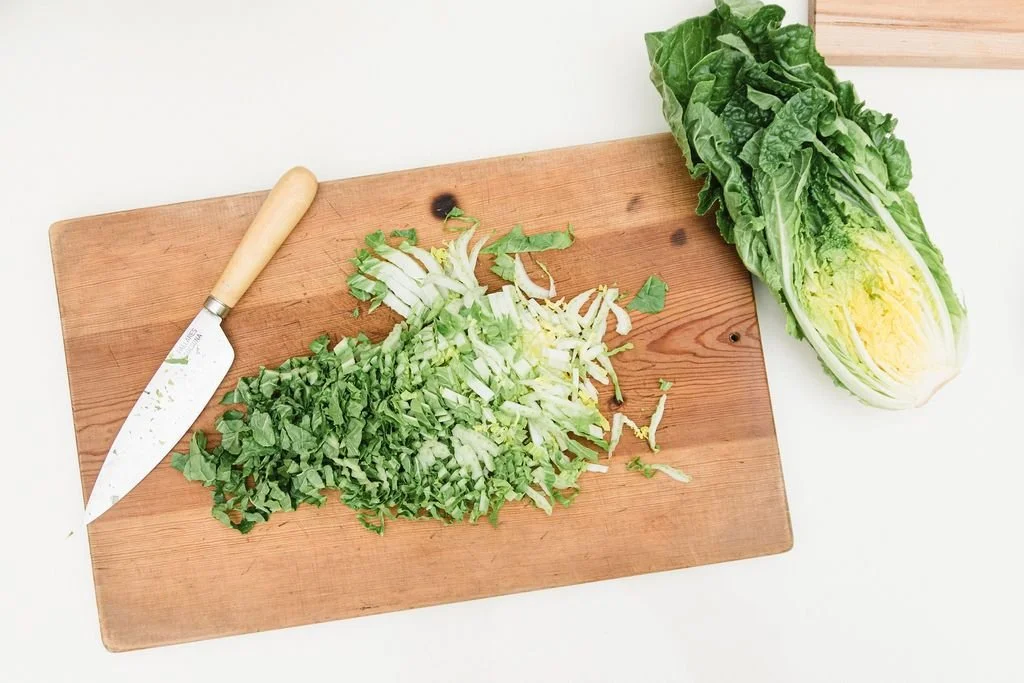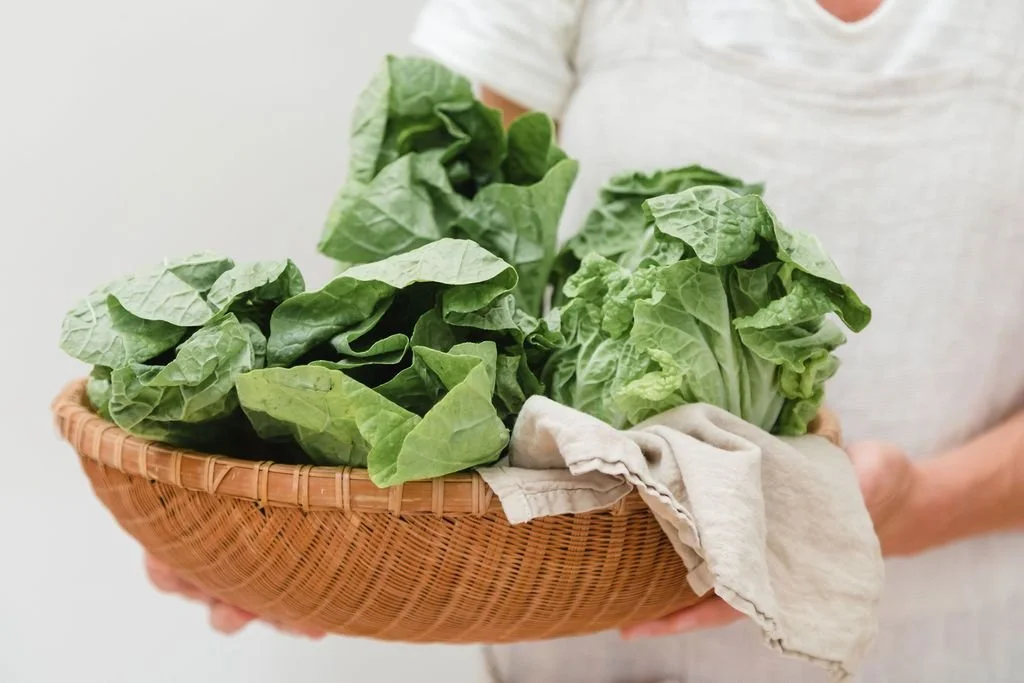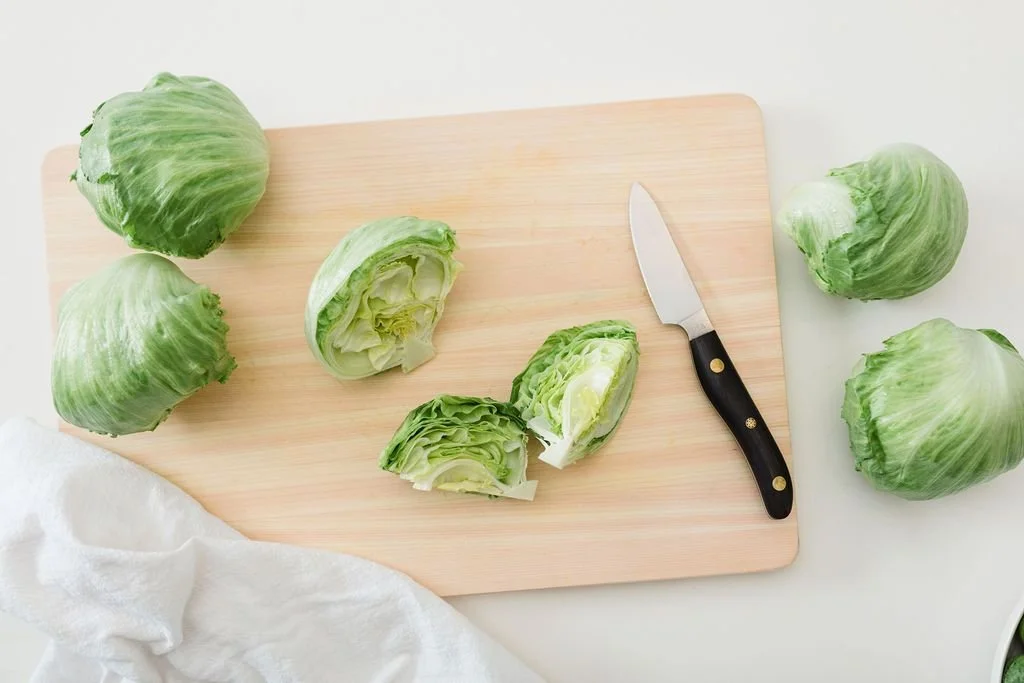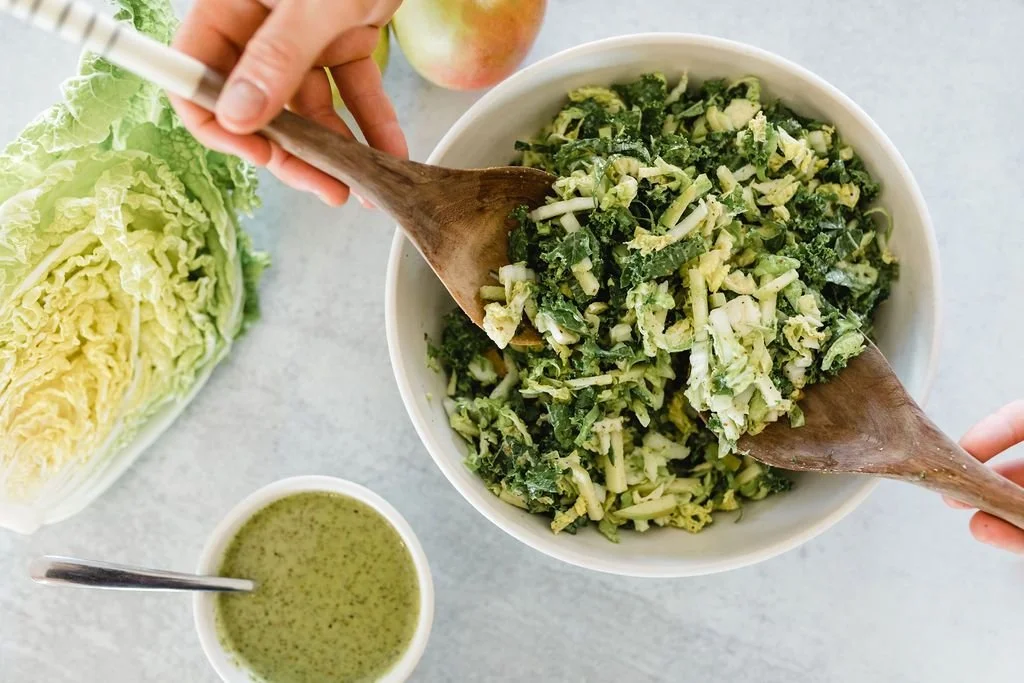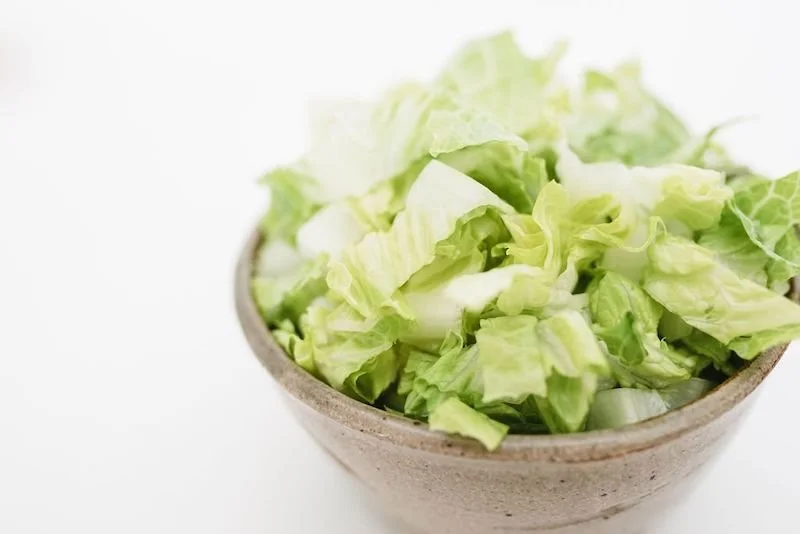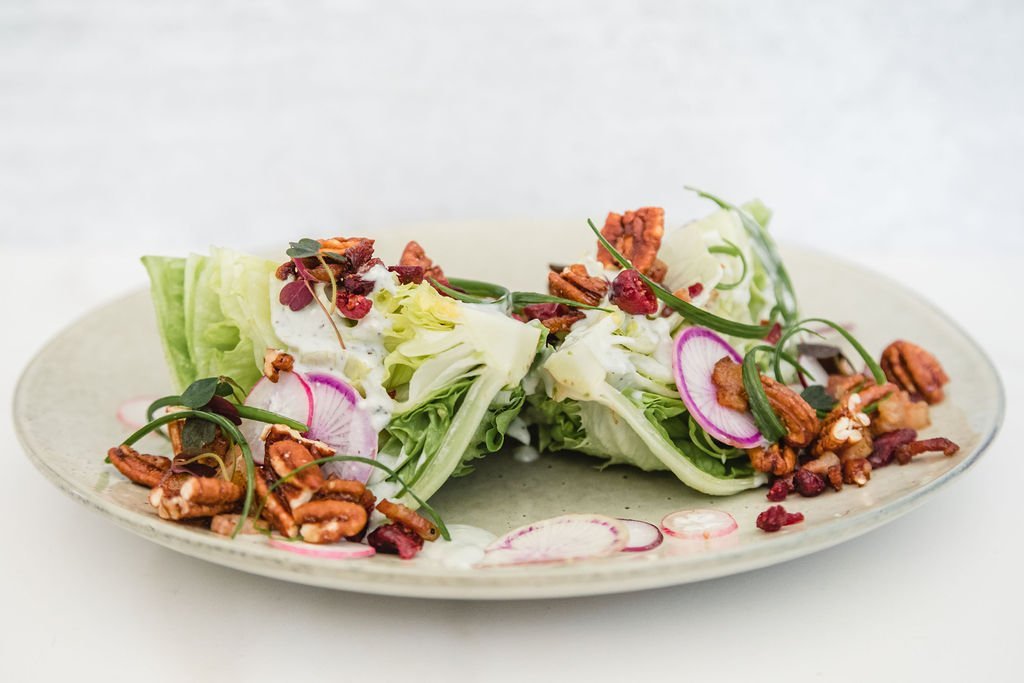Want to shred lettuce like a pro? It’s easier than you might think.
In just minutes, you’ll have crisp, fresh lettuce ready to go. It’s cheaper than the bagged stuff, and you get to control exactly how it’s cut.
Keep reading for simple tips to master the technique—and a few tasty recipe ideas to try out.
Before You Shred: Lettuce Prep + Kitchen Pro Tips
Choose Fresh
The best lettuce prep starts at the produce section. Take a close look before you buy. Pass on heads that show any signs of wilting or discoloration.
Pull back a few outer leaves, and take a sniff. Healthy lettuce has a pleasantly clean fragrance.
Tip: Make sure you're buying fresh produce supplied by trusted growers, like Hitchcock Farms.
Remove the Core
Removing the core from the lettuce head makes it much easier to shred the leaves.
Start by giving the bottom of the head a solid whack against the kitchen counter. Loosen the core by wiggling the stem end, and then smack it on the counter again.
The core should pull out, leaving the rest of the head intact.
If you're prepping romaine lettuce heads, cut around the bottom of the stem with a paring knife.
Angle the blade up and around the core in a complete circle. Ease the core out by twisting and pulling the stem.
Tip: Packaged romaine hearts are already trimmed down to their inner leaves, and that saves prep time.
Check, Wash, and Drain
Once the lettuce core is out, ruffle back the leaves, and check for damage or debris.
When the head passes your inspection, immerse it in a bowl of cold water. Gently swish, and then let it soak for 10 minutes.
Place the clean head in a colander, cover with a dish towel, and shake the lettuce until it's dry.
Tip: Save lettuce-drying time by letting a salad spinner do the work.
The Best Ways to Shred Lettuce
1. Slice With a Sharp Knife
For this method, all you need is a sharp kitchen knife and a cutting board.
Some home cooks prefer a plastic lettuce knife, and others stick with a traditional chef's knife.
Both options will give you good results as long as the blade has been recently sharpened.
Lay a dish towel under your cutting board to keep it in place.
Position the head of lettuce on your cutting board, stem side down.
Use your thumb and forefinger to pinch the base of the blade where it meets the handle. Wrap your other fingers around the handle.
Use your non-dominant hand to hold the lettuce in place while cutting. Curl your fingers inward so your hand forms a claw shape. This secures your grip and protects your fingertips from the blade.
Slice the lettuce head in half. Place each half on the cutting board, cut-side down, and slice each piece in half again.
Lay each quarter cut-side down, and slice into shreds.
Keep shredding widths uniform, between 1/8 and 1/4 inch.
Tip: Compact baby iceberg heads only need to be cut into halves before slicing.
Pros:
You have complete control over the size of the shreds when chopping by hand.
Prep and cleanup are quick and easy.
Cons:
Shredding lettuce with a knife can be time-consuming.
The technique can be hard to master if you're new to cooking.
Best For:
Greens with loose leaves, like romaine, green leaf lettuce, and red leaf lettuce.
Small amounts of lettuce you need to prep quickly, such as shredded iceberg to top tacos or sandwiches.
Salads that call for larger cuts of lettuce.
2. Sliver With a Box Grater
A box grater is an essential and versatile kitchen tool.
While you can shred some vegetables with a flat hand grater, you really need the stability of a box grater to shred heads of lettuce.
Cut the lettuce head in half and then into quarters using a sharp kitchen knife.
Dry the lettuce before shredding with the grater.
Hold the grater over a large bowl or cutting board secured to the counter. Alternatively, place the grater directly inside a large glass bowl.
Position the grater so that you have access to the side with the large holes.
Rub the cut side of the lettuce quarters downward against the grater, using a gentle but firm pressure. Continue the motion until almost all the lettuce is shredded.
Tip: When you're left with only a small piece of lettuce, slice it up by hand to avoid getting your fingers caught in the grater.
Pros:
Grating is faster than cutting by hand.
The lettuce shreds will be perfectly uniform.
Cons:
Although faster than slicing by hand, grating large quantities of lettuce can still be time-consuming and tiring.
It's easy to accidentally slice your fingertips on a box grater.
Best For:
Tightly packed lettuces like cabbage, iceberg, and radicchio.
Medium to large quantities of lettuce.
Recipes that call for fine and consistent shreds, like our Napa Cabbage Chopped Salad.
3. Shred With a Food Processor
A food processor has practically limitless functions in your kitchen, and one of its many uses is shredding vegetables.
As long as you have the right attachment, any food processor can successfully shred lettuce. You don't need the newest or fanciest model to get the job done.
Cut the lettuce into quarters with a sharp knife. Depending on the size of the lettuce head and the size of your food processor, you may have to chop the lettuce into smaller pieces until it fits.
Set up your food processor by positioning the drive adapter inside the work bowl.
Place the shredding blade face up onto the adapter, and close the lid. The s-blade can chop up the lettuce, but it won't cut it into uniform pieces like the shredding blade will.
Slide a single lettuce quarter into the processor, using the pusher tool.
Turn the processor on as the lettuce moves into the feed tube, and run at a low speed until fully shredded.
Tip: For extra crisp shredded lettuce, pop the lettuce quarters in the fridge or an ice water bath for 10 minutes before processing—cold lettuce shreds more cleanly and holds its texture better.
Pros:
The food processor is the fastest way to shred large amounts of lettuce.
Food processors are beginner-friendly as long as you know how to operate yours.
Cons:
Soft types of lettuce, like butter lettuce or arugula, could end up bruised or wilted.
Setting up and cleaning up the processor may not be worth it for small amounts of lettuce.
Best For:
Firm and compact lettuces that don't wilt or get soggy easily, such as iceberg and romaine.
Recipes that call for larger quantities of shredded lettuce.
5 Tasty Recipes With Shredded Lettuce
1. Romaine Heart Caesar Salad
Trade out chopped lettuce for thin-sliced romaine hearts. Mix in roasted pepitas and shaved parmesan.
Finish this unique Caesar salad with a fiery jalapeno and cilantro dressing.
Make It Yours: Make every seed of a fall pumpkin count by baking your own yummy pepitas.
2. Iceberg Lettuce Coleslaw
Iceberg lettuce delivers a sweetly tender crunch that transforms traditional coleslaw into a lighter dish.
Customize it with your own mix of favorite veggies, thinly sliced and tossed with the shredded lettuce.
Make It Yours: Think past the mayo by drizzling lettuce slaw with a buttermilk or sour cream dressing.
3. Baby Iceberg Steakhouse Salad
Start with a small wedge of baby iceberg lettuce. Slice it thin, and top the crispy veggie shreds with bacon bits and pecans.
Turn the dish into a classic steakhouse salad with a generous drizzle of homemade Roquefort.
Make It Yours: Thin-sliced romaine hearts are also an excellent fit in this elegant dinner salad.
4. Romaine and Cucumber Salad
The slightly sweet flavors of romaine and cucumber create culinary harmony in a very healthy salad.
Christen with a yogurt dressing, crown with toasted walnuts, and enjoy the salad as a meal or a side.
Make It Yours: Romaine and cucumber salad pairs especially well with roasted pork tenderloin or grilled chicken.
5. Heart of Romaine Fattoush
If you love the benefits of a Mediterranean diet, put this romaine heart fattoush at the top of your salad list.
The flavor medley includes Persian cucumbers, sliced red onion and crumbled feta.
Make It Yours: Try trading out the recipe's pita bread with chapati, naan or even toasted flour tortillas.
From Our Family Fields to Your Table
We know you enjoy adding new tricks to your culinary skill set. It's even more satisfying when you can perfect your techniques and prep meals like a professional chef.
Whether you're shredding baby iceberg lettuce or slicing romaine hearts, we're proud to be a part of your culinary adventures.
We're also proud of our family operations here at Hitchcock Farms, growing and supplying the finest premium produce available.
From our family fields to your table, you have our commitment to always serving you with our very best.
FAQs
How many cups are in a head of lettuce?
A typical head of iceberg weighs 1 pound and yields approximately 12 cups of shredded lettuce.
An average head of romaine lettuce yields 4 to 6 cups of shredded lettuce.
Is it better to cut or tear lettuce?
If your recipe calls for shreds or thin slices, working with a knife produces a better ingredient.
If you want to garnish a hamburger with lettuce leaves, tear them to size so that they fit the bun.
Should you wash lettuce after shredding or before?
Always wash and dry your lettuce before shredding it.
This helps spot any overlooked wilting or blemishes on leaves. It also ensures the lettuce is clean before using it in your recipe.

